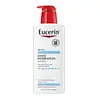What's inside
What's inside
 Key Ingredients
Key Ingredients

No key ingredients
 Benefits
Benefits

 Concerns
Concerns

 Ingredients Side-by-side
Ingredients Side-by-side

Water
Skin ConditioningGlycerin
HumectantCetyl Palmitate
EmollientParaffinum Liquidum
EmollientCaprylic/Capric Triglyceride
MaskingOctyldodecanol
EmollientCetyl Alcohol
EmollientGlyceryl Stearate
EmollientColloidal Oatmeal
AbsorbentDimethicone
EmollientMethylpropanediol
SolventPEG-40 Stearate
Emulsifying1,2-Hexanediol
Skin ConditioningPhenoxyethanol
PreservativePiroctone Olamine
PreservativeCarbomer
Emulsion StabilisingBenzyl Alcohol
PerfumingPolyglyceryl-2 Caprate
EmulsifyingDecylene Glycol
Skin ConditioningWater, Glycerin, Cetyl Palmitate, Paraffinum Liquidum, Caprylic/Capric Triglyceride, Octyldodecanol, Cetyl Alcohol, Glyceryl Stearate, Colloidal Oatmeal, Dimethicone, Methylpropanediol, PEG-40 Stearate, 1,2-Hexanediol, Phenoxyethanol, Piroctone Olamine, Carbomer, Benzyl Alcohol, Polyglyceryl-2 Caprate, Decylene Glycol
Water
Skin ConditioningHelianthus Annuus Seed Oil
EmollientPetrolatum
EmollientGlycerin
HumectantGlyceryl Stearate Se
EmulsifyingOctyldodecanol
EmollientCaprylic/Capric Triglyceride
MaskingPentylene Glycol
Skin ConditioningPalmitic Acid
EmollientStearic Acid
CleansingPhenoxyethanol
PreservativeDimethicone
EmollientCetearyl Alcohol
EmollientCaprylyl Glycol
EmollientPanthenol
Skin ConditioningTocopheryl Acetate
AntioxidantCholesterol
EmollientCarbomer
Emulsion StabilisingSodium Hydroxide
BufferingTrisodium EDTA
BHT
AntioxidantWater, Helianthus Annuus Seed Oil, Petrolatum, Glycerin, Glyceryl Stearate Se, Octyldodecanol, Caprylic/Capric Triglyceride, Pentylene Glycol, Palmitic Acid, Stearic Acid, Phenoxyethanol, Dimethicone, Cetearyl Alcohol, Caprylyl Glycol, Panthenol, Tocopheryl Acetate, Cholesterol, Carbomer, Sodium Hydroxide, Trisodium EDTA, BHT
 Reviews
Reviews

Ingredients Explained
These ingredients are found in both products.
Ingredients higher up in an ingredient list are typically present in a larger amount.
This ingredient is an emollient, solvent, and texture enhancer. It is considered a skin-softener by helping the skin prevent moisture loss.
It helps thicken a product's formula and makes it easier to spread by dissolving clumping compounds.
Caprylic Triglyceride is made by combining glycerin with coconut oil, forming a clear liquid.
While there is an assumption Caprylic Triglyceride can clog pores due to it being derived from coconut oil, there is no research supporting this.
Learn more about Caprylic/Capric TriglycerideCarbomer is a polymer of acrylic acid. Its main role is to create a gel consistency.
A high amount of carbomer can cause pilling or balling up of products. Don't worry, most products contain 1% or less of carbomer.
Dimethicone is a type of synthetic silicone created from natural materials such as quartz.
What it does:
Dimethicone comes in different viscosities:
Depending on the viscosity, dimethicone has different properties.
Ingredients lists don't always show which type is used, so we recommend reaching out to the brand if you have questions about the viscosity.
This ingredient is unlikely to cause irritation because it does not get absorbed into skin. However, people with silicone allergies should be careful about using this ingredient.
Note: Dimethicone may contribute to pilling. This is because it is not oil or water soluble, so pilling may occur when layered with products. When mixed with heavy oils in a formula, the outcome is also quite greasy.
Learn more about DimethiconeGlycerin is already naturally found in your skin. It helps moisturize and protect your skin.
A study from 2016 found glycerin to be more effective as a humectant than AHAs and hyaluronic acid.
As a humectant, it helps the skin stay hydrated by pulling moisture to your skin. The low molecular weight of glycerin allows it to pull moisture into the deeper layers of your skin.
Hydrated skin improves your skin barrier; Your skin barrier helps protect against irritants and bacteria.
Glycerin has also been found to have antimicrobial and antiviral properties. Due to these properties, glycerin is often used in wound and burn treatments.
In cosmetics, glycerin is usually derived from plants such as soybean or palm. However, it can also be sourced from animals, such as tallow or animal fat.
This ingredient is organic, colorless, odorless, and non-toxic.
Glycerin is the name for this ingredient in American English. British English uses Glycerol/Glycerine.
Learn more about GlycerinOctyldodecanol is a fatty alcohol. It is primarily used to enhance the texture of products.
As an emulsifier, Octyldodecanol helps prevent the oils and waters from separating. It also prevents ingredients from creating foam when shaken.
Octyldodecanol is created by reducing fatty acid to an alcohol.
Due to its high molecular weight, it does not get absorbed into the skin.
Learn more about OctyldodecanolPhenoxyethanol is a preservative that has germicide, antimicrobial, and aromatic properties. Studies show that phenoxyethanol can prevent microbial growth. By itself, it has a scent that is similar to that of a rose.
It's often used in formulations along with Caprylyl Glycol to preserve the shelf life of products.
Water. It's the most common cosmetic ingredient of all. You'll usually see it at the top of ingredient lists, meaning that it makes up the largest part of the product.
So why is it so popular? Water most often acts as a solvent - this means that it helps dissolve other ingredients into the formulation.
You'll also recognize water as that liquid we all need to stay alive. If you see this, drink a glass of water. Stay hydrated!
Learn more about Water